Some people who are self-published make hundreds of thousands of dollars.
Many more make a few dollars.
Some who buy a high-priced package of services for self-publsihing may end up losing money.
Some get a glowing review from the New York Times' Michiko Kakutani. (Who, as Annie Lamott once said:" The one little problem with Michiko, though, is that if she doesn't like your book, she will kill you -- cut your head off with a surgical knife, and play hacky-sack with it until she grows bored. Then, maybe in the last paragraph, she'll pour acid on it.") (Read more about her here.)
Most never get noticed.
And no one really knows why something like 50 Shades of Grey is a huge success.
When I got my first contract in 1997, the only people who self-pubbed were deluded fools who ended up with boxes of books in their basement. I still meet people who have paid thousands to have their picture book published with cheap materials and bad drawings. (Often, sadly enough, they seemed to be suckered in by a company that claims to be Christian.)
I've seen people break with traditional publishers, and people who have had success self-publshing happily sign with one of the Big Six (or is it Big 5 now?).
Recently, I've read two interesting articles about self-publishing.
One lengthy one in Time magaizne says, "Its an article of faith in the indie movement that writing fiction can be a way to get rich."
Here's a link to a pdf of the article called The 99-Cent Bestseller. he author they profile earned $352.70 in nine months. Not get-rich-quick stuff.
NPR also covered self-publishing, including looking at the prices people pay for help in getting their book in e-print.
I have put all my backlist out as ebooks. I seldom earn more than $300 a month. But hey, it's free money (I did the formatting and my husband did the covers), and it means that people are still reading my older books.
My ebooks and another ebook that for some reason isn't showing up when I click Kindle.
Viewing: Blog Posts Tagged with: Self-Publishing, Most Recent at Top [Help]
Results 76 - 100 of 300
Blog: So many books, so little time (Login to Add to MyJacketFlap)
JacketFlap tags: self-publishing, money, self-pubbed, Add a tag
Blog: JD'S Writers Blog (Login to Add to MyJacketFlap)
JacketFlap tags: Picture books, publishing, self-publishing, printing, JD Holiday, resizing images, Indesign CS 3, Corel PaintShop Pro, Add a tag
To start with, here, I am using PaintShop Pro to resize images and add frames, edges and borders to some of them to neaten them up.
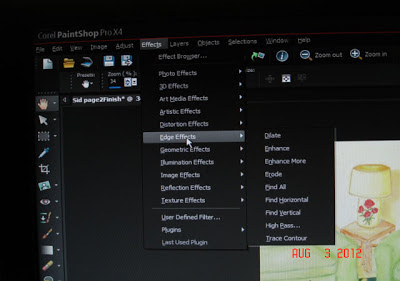 |
| Here, I'm using EFFECTS, then choosing EDGE EFFECTS for this image. |
 |
| 1. Here, I'm using IMAGE> PICTURE FRAME. |
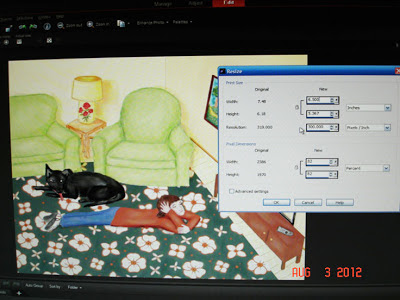 |
| Making sure the images are at least 300 dpi or higher. NEXT: Moving To My Book program: Indesign CS 3 How I Make My Picture Books: Part II |
Blog: JD'S Writers Blog (Login to Add to MyJacketFlap)
JacketFlap tags: Picture books, publishing, self-publishing, printing, JD Holiday, resizing images, Indesign CS 3, Corel PaintShop Pro, Add a tag
The books for Indesign CS 3 that I have are:
Adobe Indesign CS3 Bible by Galen Gruman. I use this one as a reference book.
Adobe Indesign CS3 Classroom in a Book
I found Indesign to be a fun program to work in. It has some much more to it than I use.
There are many tools and you have to familiarize yourself with them so you can use the ones you will need for your project.
The tools I used most are:
Direct Selection Tool - to grab and size pages and images
Selection Tool - moving and re-sizing images
Type Tool - the Type Tool makes the frames needed to place your text in. To edit and format with the
Type Tool. It works much like word processing software. Indesign has auto-fill which you use
by load the Type Tool and it flows through the text frames. However, I manually add my text
due to the amount of images, the small amount of text on some pages and how I design my
pages.
In Indesign, you make images and frames. For text frames you place your text either using 'auto fill' or cut and pasting then place a image and the two frames click together. Then you do it again for the next page, and on and on.
If your images are your pages, and you plan to add text into them you selected the Type Tool and place the text where you want it in the image.
Before we get started, let me remain you to SAVE often while you are working in Indesign.
You start by creating a document.
Start Indesign. Choose FILE: then, NEW: then, DOCUMENT
| Here I am opening the document. FILE: NEW: DOCUMENT |
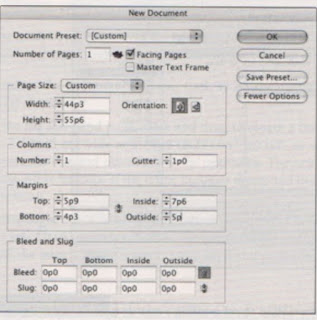 |
| The file opens and this is what it looks like. |
I don't worry about the SLUG area.
You can save your PRESET for later use for another book.
| Here you see that I have a PRESET for chapter books. |
Here the DOCUMENT is open. This is a title page/first page of the document.
~
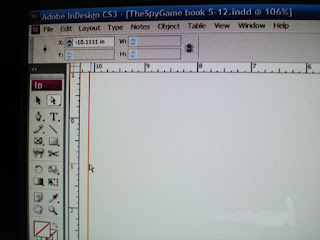 |
| A |
I did just what I had in the example above, and COPIED and PASTED the text from my word processor and added it to the area I had painted for that purpose.
Throughout this process you are designing your book!
Now you will show how I send my BOOK DOCUMENT to my printer.
To return to Part I: http://jdswritersblog.blogspot.com/2013/02/how-i-make-my-picture-books-part-i_8924.html
To go to Part III: http://jdswritersblog.blogspot.com/2013/01/how-i-make-my-picture-books-part-iii.html
Blog: JD'S Writers Blog (Login to Add to MyJacketFlap)
JacketFlap tags: Picture books, publishing, self-publishing, printing, JD Holiday, resizing images, Indesign CS 3, Corel PaintShop Pro, Add a tag
To start with, here, I am using PaintShop Pro to resize images and add frames, edges and borders to some of them to neaten them up.
 |
| Here, I'm using EFFECTS, then choosing EDGE EFFECTS for this image. |
 |
| 1. Here, I'm using IMAGE> PICTURE FRAME. |
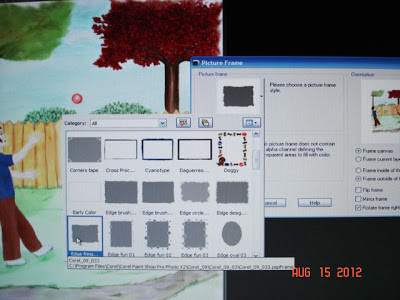 |
2. Here you see there are a number of choices. For printing books your printer will need the resolution or DPI /Dots Per Inch to be 300 DPI or 600 DPI. I always scan in my images at 300 DPI. A higher DPI means a higher quality print, image or screen resolution. (NOTE: Also know, that the larger the images the more space each image will need on your computer for storaging them. This is important to know because the more high resolution images on you drive can stop some programs from running due to limiting usable space on the hard drive.) I pick the size of each image due to the size page that it will fit on in my book. |
 |
| Making sure the images are at least 300 dpi or higher. NEXT: Moving To My Book program: Indesign CS 3 How I Make My Picture Books: Part II |
Blog: Original Content (Login to Add to MyJacketFlap)
JacketFlap tags: publishing, self-publishing, book blurbs, reading blogs, Add a tag
I've actually had a little time to look at some of the Internet gleanings I've been saving up these past few weeks. And I can't wait to discuss them.
It took a while for me to get around to The Last Word on Blurbs at Educating Alice, because the documentary about Gary Shteyngart's blurbs that Monica links to runs 15 minutes. When I finally saw the little film, I found it interesting because it seems to project the pointless nature of blurbs and suggest that the literary world, itself, doesn't take them seriously, while all that same time portraying Shteyngart, a well-known "blurb whore" in blurbing circles, as a nice guy trying to be helpful. As I was watching it, I imagined hundreds, if not thousands, of writers contacting him, hoping for a blurb, not because it would say anything particular about the quality of their books but because it would be neat to have a Shteyngart blurb. I'm thinking it could be like collecting autographs or balls signed by athletes.
Some of what you'll see at Six Things I Learned About Publishing a Book That Very Few Books Will Tell You at The Huffington Post you probably have seen in a lot of books. However, I was particularly interested in Points 1 and 2. 1. The author, Nataly Kelly, talks about connecting with an editor on LinkedIn. I have wondered about whether or not LinkedIn would be useful. I rarely hear any talk of it in author promotion materials. However, my limited knowledge of it suggests that it is professional rather than social. Shouldn't that mean you'll get fewer political rants and odes to pets there and more real professional exchanges? I could be convinced to link up with LinkedIn. 2. Kelly says an agent is necessary to assist with negotiations, even if you "made" the sale yourself. I've often heard that. However, in this video Mark McVeigh did for the 2010 WriteonCon, he said that getting an agent at that point is a little late, and that for most new authors, an agent won't be able to do much more for you than the editor's original offer. Which way to go? I am at a loss.
New Developments in Self-Publishing at Turbo Monkey Tales. Note that in spite of the new technical developments related to self-publishing, the post also makes the point that self-publishing is still publishing. In order to publish a book, someone has to do the work of a publisher--"editing, design, and marketing, at the very least." If authors publish themselves, then they either have to do that work or they have to pay someone to do it. But there's no getting around the fact that it needs to be done.
And while we're talking about writers needing to spend money, as we were in that last para, let's also touch on them making money. The financial realities described for genre novelists are similar to those for children's novelists. I would add something to this quote from the excerpt from Brian Keene: "And you probably won’t see a royalty check until another year AFTER your book has been published (provided enough copies have sold to earn out your advance)." The part about "provided enough copies have sold to earn out your advance" is extremely important. Many books never sell enough copies to earn out the authors' advances, and, thus, those authors never see a royalty check, never see money beyond the original advance. Some authors only make money the years they receive advances.
Okay, we're going to end this weekend's links on a lighter note. Maybe. Take a look at 7 (More) Children's Books by Famous "Adult" Lit Authors at Brain Pickings. My personal favorite is the first one, The Crows of Pearblossom, by Aldous Huxley. It's about a crow couple who are having no luck at all starting a family because a rattlesnake that lives below their tree keeps eating their eggs. Seriously. It eats 297 of them. They trick the snake into eating two stone eggs, which, as you might guess, kills him. They then go on to live happily ever after, I guess, with the 60-plus children they proceed to produce. There is a Greek tragedy element to this story that appeals to me.
Blog: PW -The Beat (Login to Add to MyJacketFlap)
JacketFlap tags: Isaac Lenkiewicz, review, Reviews, Comics, self-publishing, Christophe Blain, Joe Lambert, Add a tag
TweetOk, so the title’s a bit dubious, but I thought it’d be nice to have a feature where we look at 3 comics, the criteria being that these are either older books I’ve missed, or smaller, self published work. To kick things off, a top notch trio- I enjoyed each one of these offerings immensely, albeit in different ways. [...]
Blog: Writing and Illustrating (Login to Add to MyJacketFlap)
JacketFlap tags: Self-Publishing, article, Survey, authors and illustrators, Digital Book World, demystify, Jeremy Greenfield, What Authors Want, News, Add a tag
What Authors Want: Third of Published Authors Interested in Self-Publishing Next Book by Jeremy Greenfield for Digital Book World

The lure of self-publishing is showing that it has some appeal even to authors who have been accepted and invested in by traditional publishing houses.
A third of traditionally published authors are interested in self-publishing their next book, according to a new survey from Digital Book World and Writer’s Digest.
The survey, What Authors Want: A Comprehensive Survey of Authors to Understand Their Priorities in the Self-Publishing Era, queried nearly 5,000 aspiring, self-published, traditionally published and “hybrid” authors (authors who have both self-published and traditionally published). It was presented in a keynote presentation at the Digital Book World Conference + Expo.
This trend should be worrisome for traditional publishers, which are struggling to demonstrate to the marketplace that they add value to the publishing process in an era where anyone can publish a book.
Perhaps of even more concern is that two-thirds of hybrid authors are interested in self-publishing their next book. It’s not surprising given the context of the rest of the survey: Time and again, hybrid authors had relatively negative opinions about publishing companies — that they keep too much money, don’t “get” digital and, generally, don’t add much to their publishing process.
At the same time, when offered the opportunity to publish traditionally, nearly three-quarters of hybrid authors are interested and — also good news for publishers — about two-thirds of self-published authors are interested. Not surprisingly, 92% of traditionally published authors are interested. The prestige of a traditional publisher, the wide distribution a publisher can generate and help with marketing were all reasons cited.
The wide-ranging survey also dived into how authors are building their social media platforms, what they think about advances, royalties, ebook prices, agents, ebooks in libraries and more. A full report will be available on DigitalBookWorld.com in a few weeks.
Pre-order the full report on what authors want here.
Talk tomorrow,
Kathy
Filed under: article, authors and illustrators, demystify, News Tagged: Digital Book World, Jeremy Greenfield, Self-Publishing, Survey, What Authors Want
Blog: PW -The Beat (Login to Add to MyJacketFlap)
JacketFlap tags: Small Presses, Art, self-publishing, Breaking News, Becky Cloonan, Add a tag
TweetBecky Cloonan, she of making universally acclaimed mini-comics when not drawing Batman, Swamp Thing, Northlanders and Demo fame, has just announced that this year she’ll be publishing her third mini-comic. This will follow the previous success of her self-published comics Wolves and The Mire. Called Demeter, here’s the teaser image for the comic Cloonan revealed only scant moments [...]
Blog: Original Content (Login to Add to MyJacketFlap)
JacketFlap tags: Saving the Planet e-book, self-publishing, Add a tag
Publishing is hard. And takes a long time. So the ebook edition of Saving the Planet & Stuff will be coming out in February and not at the end of this month, as originally planned.
We (my computer guy and I) are publishing STP&S the hard way. In part, this is because when we started this project, we weren't aware there was an easy way. Now that we know more about this process, we probably would have had to go the hard way, anyway. STP&S is full of font changes because of instant messages, e-mails, post cards, and quotes from magazines and newspapers. (Book Links included it in an article called The Text Generation: Fiction That Incorporates Digital Communication.) That would have raised the cost of hiring someone to do this for us (the easy way), though we don't know by how much. I am happy to have paid for the beautiful new cover. However, because I don't know if I'll make back my investment on this project, I do have to give consideration to how great that investment will be.
An additional problem is the material we had to start with. Many "how-to" explanations for publishing ebooks say to begin with your Word document. Because we were republishing a published book that had been professionally edited and copy edited, I didn't have a Word document that was exactly what was in the published book. We made editing changes directly onto the last manuscript I sent my editor. We made changes on the publisher's created copy. We made minute copy changes. In order to truly republish STP&S, I couldn't use anything I had on my computer.
So we sent one of the books off to be scanned and received back the copy in three different files, from which CG chose one to work with. The scanning process made a lot of typographical changes that needed to be corrected. HTML was involved. We had to determine how the copyright page would look. We had to determine...this and that and a dozen other things.
In short, we're not quite done. And once our finished work is uploaded to Kindle and Nook, we could find ourselves with more problems. The book is still coming, just not yet.
I have been spending large quantities of time on things like writing the product description for Amazon and Barnes & Noble, seeking out blogs that might be interested in featuring the book, planning the trailer (which was completed months ago, though not uploaded--I'll explain why another time), and copy editing the text three times. Dealing with the hardcore technical stuff has fallen on Computer Guy. Early last year when we first discussed doing this, he said he thought it would be fun. It hasn't looked as if he's been having fun to me. However, a few weeks ago, he said, "You've got the rights back to My Life Among the Aliens, don't you? We can go right to work on getting that ready to publish." My response was, "Noooo. I need to do some writing this year." "But I can get started on my part," he insisted.
Clearly computer guys have an unusual definition of fun.
Blog: Writing and Illustrating (Login to Add to MyJacketFlap)
JacketFlap tags: article, Pearson, Penguin, authors and illustrators, Author Solutions, Book Country, Book Distribution tool, ebook creation and publication, Book, reference, Self-Publishing, Add a tag
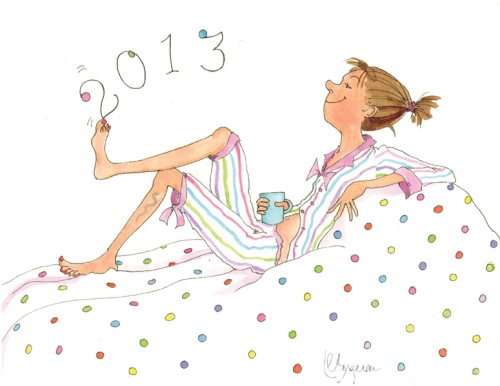
This January illustration was sent in by illustrator Louise C Bergeron. Her work always makes me smile.
In the past month, I have gotten a number of requests for self-publishing information, thus the reason for sharing this information with you. The one important piece of advice I can personally share is not to rush your book out, because you are excited and can’t wait. If you want your self-published book to stand up to the big boys, you need to cross every “t” and dot every “i”. We’ll talk more about that over the weeks.
Digital Book Wired reported:
Responding to a changing self-publishing landscape, including Pearson’s acquisition of leading self-publishing services provider Author Solutions, Penguin’s Book Country workshopping and self-publishing community has made some changes and added new features, including a free ebook creation, publication and distribution tool. It has also raised the royalty rate that it offers authors to 85% of net sales, up from 70%.
Book Country had taken criticism from self-published authors for charging authors for publishing services and for the percent of revenues that it takes after the book goes on sale. Author Solutions, now a sister company to Book Country, has also faced similar criticism.
The writer community and self-publishing platform will also now offer an online editor service that will help authors with their ebook formatting issues. The self-publishing tool will now also be open to all kinds of writers, not just writers of genre fiction, which the tool was focused on before. The writing community, however, will still be limited to genre work. Book Country will now distribute to more retailers and also be abandoning its print self-publishing capabilities.
Since its April launch, www.BookCountry.com has nearly 4,000 members who have posted 500 pieces of fiction, according to the company.
The self-publishing tool is integrated with Book Country’s “genre map,” a detailed classification system of many genres and sub-genres, offering authors fairly sophisticated marketing capabilities, including use of BISAC codes that help readers find books in their area of interest. Users are also given an online marketing guide and advice on pricing through a pricing calculator. Revenues from books sold are to be split between Penguin and the authors, depending on the price the author selects for the book and the distribution method.
“You don’t have to drive around with books in the back of your Subaru anymore”, said Penguin global digital director Barton.
Users can opt for professional print- and e-book production through outsourced firms for $549, produce it themselves for print and digital distribution for $299 or produce it themselves for e-book-only distribution for $99.
*******
Random House sold 11.2 million ebook units; Hachette 8.7 million; Harper UK 7.2 million, and Pan Macmillan 4.5 million. Some of those units were driven by the deep-discount 20-pence promotional bestsellers that have roiled the UK market in recent months.
*******
ePublisher Premier Digital announced a strategic alliance with Ingram in a lengthy press release that doesn’t really explain the business relationship, except to say that it covers “the management and distribution of print and digital content” though Ingram’s “integrated print, digital, and full-service distribution services.”
Talk tomorrow,
Kathy
Filed under: article, authors and illustrators, Book, reference Tagged: Author Solutions, Book Country, Book Distribution tool, ebook creation and publication, Pearson, Penguin, Self-Publishing
Blog: Paranormal Point of View (Login to Add to MyJacketFlap)
JacketFlap tags: self-publishing, traditional, indie, Add a tag
This isn't about competition. Most people think it is. That only one format can come out on top. I'm not here to play that game. Personally I believe they can coexist and in fact, I'm going to continue to pursue both. But I do want to take a look at the pros and cons of both as I see them in a series of blogs. I know there are so many people out there better researched than I, but maybe you're just as confused as I was not that long ago and perhaps a layman's view will come in handy.
Today I want to look at Publicity.
Traditional:
- Pros:
- Sometimes you get a publicist!
- You have a name behind you
- You have wider exposure in print
- Cons:
- Most new authors have to promote themselves
- Other books from the publisher may take precedence
- Pros:
- You can release more books in a shorter period of time (provided you still use professional editing/copyediting/design etc.)
- The publisher (sometimes you) might be better invested in your book.
- Cons:
- You definitely have to promote yourself
- You can pretty much count B&N out unless you are doing NOOK.
Blog: Redheaded Stepchild (Login to Add to MyJacketFlap)
JacketFlap tags: children's books, picture books, Self-publishing, children's illustration, hiring and illustrator, Add a tag
Since I started my journey as a children's illustrator, I've been approached by so many authors who want me to illustrate their books. It surprises me how little research the majority of them have done!
One of my biggest pet peeves is the subject of rights. Most authors are unable (or unwilling) to pay a fair fee to an artist to illustrate a picture book ($3,000 and up for a typical 32-page book), but also expect to get all rights to the artwork for that fee! Why? Traditional publishers don't even do that.
Typically, the payment gives all book rights to the author. Which means that the illustrator can't sell the art to anyone else to be used in another book, and the author is free to use the art to promote the book. That's all you need!
Then this question comes up: "What if my book gets so popular that I want to license my characters to make plush animals or action figures out of them to sell?"
A self-published book typically makes less than $500. If that HIGHLY UNLIKELY scenario does play out, there can always be re-negotiation talks for more rights. It's sad that so many first-time authors won't hire an artist who won't give them full rights. Most professional illustrators won't agree to do that, so the talent pool for the author to choose from is shrunk to the inexperienced. I feel like the authors are really shortchanging themselves from having great art for their story. And who is going to want to buy a plush of a mediocre character anyway?
I feel better to get that off my chest. :–)
Blog: Darcy Pattison's Revision Notes (Login to Add to MyJacketFlap)
JacketFlap tags: picture books, self-publishing, winner, award, Wisdom, albatross, midway, Add a tag
Wisdom, the Midway Albatross, the subject of my 2012 picture book has returned to Midway Island and laid a new egg. She was banded by Chandler Robbins on December 10, 1956 while sitting on an egg and presumed to be a minimum of five years old. That makes her at least 62 years old–and she’s going to be a new momma. Wow!

Wisdom and her mate prepare to begin their first shift of incubation, Photo credit: Pete Leary, USFWS
More from Pete Leary, the wildlife biologist on Midway.
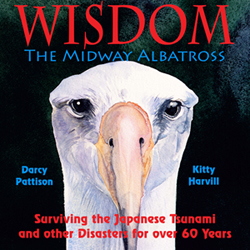

We also have exciting news about the book: it is the winner of the 20th Annual 2013 Writer’s Digest Self-Published Book Awards, in the children’s picture book category. Among other prizes is a $1000 cash award. Winners will be officially announced in the February issue of Writer’s Digest magazine.
Read more about alternate publishing. Read more about how to write a children’s picture book.
Blog: Writing for Children with Karen Cioffi (Login to Add to MyJacketFlap)
JacketFlap tags: book marketing, sell your books, Maggie Ball, KDP Select, self-publishing, book sales, Kindle, Add a tag
Three myths about KDP Select (and how you can capitalize on them)
Guest Post by Maggie BallAre you a self-publisher? In 2011, Amazon’s Kindle Direct Publishing (KDP) started a program called “Kindle Select”. To enroll in it is easy. When you upload your book into KDP, you’ll be asked if you want to enroll. Tick yes, and you’re in. That’s all there is to it, but is that all? What does it mean? In a nutshell, enrolling in KDP Select means that, for the period of enrolment, you have to commit to making the digital format of your book available exclusively through KDP. You aren’t able to distribute your book digitally anywhere else, including on your website, blogs, etc. This means that it’s unlikely that you’ll be able to enroll in KDP Select if your book is with a traditional publisher, as they’ll want to sell it from their own site and other sites as well. The benefits of doing this are:
• Your book will be available from the Kindle Owners’ Lending Library for anyone who joins Amazon Prime. Every time someone borrows it, you’ll get a share of at least $6 million throughout 2012
• 70% royalty for sales to customers in India instead of the standard 35%
• Use of a Promotions Manager tool that allows you to schedule 5 free book days a year.
It seems like a simple trade off – exclusivity for benefits, but confusion and mis-information abounds. Read on for the three biggest myths about KDP Select and what you can do to make sure that you utilise the benefits of this program to its full capabilities.
Myth one: KDP Select means you can’t sell your book on other sites.
When you enroll in KDP Select, you only have to commit to 90 days – roughly three months. After that you can put your book up anywhere. This means you can try it out, use it for a bit, and then opt out. But be careful. When you sign up, there’s an auto-renewal box. If you don’t tick off that, or diarise the renewal date, you’ll automatically be renewed and then you’ll have to wait another 90 days to opt-out. Also remember that you are free to sell print and audio copies of your book anywhere while you’re in KDP Select – it’s only for digital editions.
Myth two: If you put your book into KDP readers will come.
No promotions work without effort on the author’s part, and as more and more people become aware of KDP Select, the number of people participating in it will grow, which means more noise and more competition for attention. You’ll have to get the word out and promote your involvement as hard as you promote anything else to do with your book. Tell readers that your book is always free to borrow for Amazon Prime (you can see what Amazon gets out of it!). Tell your readers when there are free days and make sure you maximise those. Tweet and use appropriate hashtags (like @KindleBookPromos). Tell Kindle book blogs. Don’t just hope people will find out about it.
Myth three: KDP will cause you to lose sales.
Giving your book away doesn’t cause a loss of sales. It’s well known that giving your book away can dramatically increase readership awareness, potential reviews, and ultimately, sales (just ask Cory Doctorow). The more people who have heard of you, the more people will hear of you. That’s called “buzz”. It’s good.
So there are your three myth, busted. Of course I’m practising what I preach and two of my books are free this month. For Christmas, there's the poetry book Blooming Red, which I co-wrote with Carolyn Howard-Johnson, available (just click on the link below) on the 14, 15, 16, 17 and 18 of December (that would be now – go!). It makes a great thoughtful, fast electronic Christmas gift for someone you care about, and yes, you’re welcome to download, and then send it to someone. Then there's Black Cow (just click on the below) available between the 20th and 24th of December. I hope you'll download a free copy of both of these books, and try out KDP Select from the users point of view. Then drop me a line when your book is up so I can grab a copy.
Magdalena Ball runs The Compulsive Reader. She is the author of the poetry books Repulsion Thrust and Quark Soup, the novels Black Cow and Sleep Before Evening, a nonfiction book The Art of Assessment, and, in collaboration with Carolyn Howard-Johnson, Deeper Into the Pond, Blooming Red, Cherished Pulse, She Wore Emerald Then, and Imagining the Future. She also runs a radio show, The Compulsive Reader Talks. Find out more about Magdalena at http://www.magdalenaball.com.
GET YOUR FREE COPIES TODAY:
BLOOMING RED: CHRISTMAS POETRY FOR THE RATIONAL
BLACK COW
~~~~~
Blog: Galley Cat (Mediabistro) (Login to Add to MyJacketFlap)
JacketFlap tags: Amy A. Bartol, Kelly Elliott, self-publishing, Shayne Parkinson, Stephanie Bond, Self Publishing, Amanda Hocking, Courtney Milan, HP Mallory, Barbara Freethy, Karina Halle, Kristen Ashley, Self Published Best Sellers, Kelly Favor, Bella Andre, Denise Grover Swank, Raine Miller, Jae, Kate Dawes, Natasha Anders, J.A. Redmerski, June Gray, L.D. Davis, Michelle A. Valentine, Randolph Lalonde, Add a tag
 Currently selling books from her Disarm series for 99-cents apiece on Barnes & Noble, June Gray swept five spots on our Self-Published Bestsellers List.
Currently selling books from her Disarm series for 99-cents apiece on Barnes & Noble, June Gray swept five spots on our Self-Published Bestsellers List.
To help GalleyCat readers discover self-published authors, we have compiled lists of the top eBooks in three major marketplaces for self-published digital books: Amazon, Barnes & Noble and Smashwords.
We update these lists every week, tracking how writers perform inside these booming marketplaces. You can read all the lists below, complete with links to each book. If you are an author, check out our Free Sites to Promote Your eBook post and our How To Sell Your Self-Published Book in Bookstores post and our How to Pitch Your Book to Online Outlets post.
New Career Opportunities Daily: The best jobs in media.
Add a CommentBlog: PW -The Beat (Login to Add to MyJacketFlap)
JacketFlap tags: Small Presses, Interview, Interviews, Comics, Webcomics, self-publishing, Top News, Adam Cadwell, British Comic Awards, Blood Blokes, Add a tag
Adam Cadwell is a writer and artist whose works include The Everyday, an autobiographical webcomic which ran for three years between 2007 and 2010. He is currently working on the six-issue series Blood Blokes, about vampire life in Manchester.
Which, it turns out, is very similar to just plain old ‘life’ in Manchester.
He also founded Great Beast comics with Marc Ellerby, and created the British Comic Awards, which were held at Thought Bubble this year for their inaugural ceremony. He knows about web publishing, self-publishing, and how to spin brilliant answers out of somewhat-shabby questions. You come to Adam Cadwell with a problem, he’ll deal with it.
I spoke to him at Thought Bubble the morning after the BCAs were awarded, to see how they came about – and how he thinks they reflect the British comics scene in general.
Steve Morris: What inspired the British Comics Awards?
Adam Cadwell: I felt the British comics scene really needed an award which was just for British creators. There’s been a real upswing in publishing momentum, and talent and quality in the british scene over the last couple of year, and I felt that there should be a proper recognition of that talent and the stories being made.
I went to the Doug Wright awards at TCAF event in Toronto and I thought it was a really well-done awards show. There were only four awards given out, so each one felt more important or valuable. So when we decided to run the BCA we borrowed their approach – we tweaked the format slightly and included a Hall of Fame Award, but we only have five categories in total.
We wanted to make sure that the nominees all got attention and were promoted as much as the winners would ultimately be. It was more about the shortlist for each category being made up of quality titles which will entertain you and are worth your time. We could then send the shortlist to libraries as a recommended buying list, and use it to promote comics which we felt needed more attention and were worth looking at. That was really the ambition for the first year.
Steve: What’s interesting is that Britain has a different scene to America, especially in the way things are organised. We don’t have a big mainstream publisher like Marvel or DC – instead we have a series of small-press publishers and creator-owned communities. Was it interesting to get to see a cross-section of everything at once, in the nomination process?
Adam: We had an open nomination process where anyone could put forward their favourites online. We invited people to promote work they liked, and also asked publishers and creators to do the same – although we struggled to get them to, because I suppose it isn’t very British to boast about yourself. It was important that we had people get in touch and talk to us about what they liked, and in the process we got to learn about all these small publishers. Some are more prominent than others, but I think it’s a good thing that we have a lot of small publishers and collectives. I think it’s very healthy to have all these different talents working on different things.
Steve: As you can see here at Thought Bubble.
Adam: Yeah. Here everyone’s in the same room, talking to each other, and that’s how friendships and new collaborations come about. The question today seems to be about distribution, which is becoming more and more important. We have a lot of publishers, but the question is how we get these comics into libraries, how we introduce them to kids. That’s a bigger issue right now which we need to work towards.
Steve: Do you think it’s easier for new creators to get seen now, with so many new publishers establishing themselves in the British scene?
Adam: I think it depends on the quality of the work. If it’s good work, it’s easier now to get it seen, I think. We have a lot of publishers operating like Nobrow, Blank Slate, and Self Made Hero. They’re good at getting their books promoted and reviewed, but not all publishers can distribute in large numbers. For independent publishers, especially self-publishers, it can be very difficult to find outlets for selling books. Comic shows are good, but aside from that? Some shops are very supportive of self-published comics, others would rather just take free copies and “get back to you”.
Marc Ellerby and I set up Great Beast earlier this year to make a publishing banner so we could distribute self-published comics at a professional standard. We could go to wider outlets and present our works in the manner of a publisher, with everything shops need already set up – the logo, isbn numbers, barcodes. Presenting as Great Beast makes us a brand, and made it a lot easier than presenting books as an individual. As a comics culture, we need to work together on how to get these seen.
Steve: Speaking of Great Beast! You’ve been working recently on Blood Blokes, a new series about vampires living in Manchester. How has that experience been?
Adam: It’s been really good. When I first started doing it, people thought it was an odd choice because I went from doing autobiographical webcomics for four years… to this six-issue series about slacker vampires. But it does start off in autobiographical style. There’s not much vampire action in issue 1 – he gets the bus, he goes to work, he goes about a normal life. Then towards the end of issue 1, we start to explore elements of the vampire culture in Manchester.
Steve: Is it fun to play around with the more fantastical setting?
Adam: I handle the darker elements in quite a throwaway sense. It’s coming from the same place as my autobiographical works – it’s still my observations, my sense of humour about day-to-day life. But I don’t shy away from the fact the vampires are murderers, and are very casual about it. They’re monsters, but they can be as lazy and unmotivated as we can be – they’re quite like students. It’s really fun to have darker elements of horror I can throw in to surprise the reader.
Steve: What else do you have coming up?
Adam: I’m on issue 2 at the moment, working on issue 3. I’m planning it for 6 issues. I’m also doing a kids comic at the moment called The King of Things, which will be appearing in Paper Science.
I have a lot of other stories in mind for that character. It’s really bright, colourful – flexing different comics muscles for me. I’m enjoying working on them all.
Thanks to Adam for his time! You can find more from him over on his website, or head over to twitter @adamcadwell. Go!
Blog: Original Content (Login to Add to MyJacketFlap)
JacketFlap tags: editors, self-publishing, literary agents, Add a tag
You all know that I'm self-publishing an e-book version of Saving the Planet & Stuff in order to give it a life as a back list title. You know because I keep mentioning it here. You can see the cover over to the left. I have done very little since the beginning of July except work on the marketing plans for this thing and copyediting. When you have text scanned to create a digital file, a lot of errors occur. Who knew?
So, I have self-publishing on the mind. Self-publishing was on my mind when I saw Some Hard Numbers at Janet Reid, Literary Agent. Reid writes about writers who self-publish believing they'll catch a traditional publisher's eye. As she points out, they may not be aware of what catches a publisher's eye. It's sales. Big ones. By big, she's talking 20,000 books. Doesn't sound like a big number to you? Many traditionally published authors don't sell 20,000 copies of an individual title. The commenter who pointed out that a self-published e-book can continue slowly selling for years is correct. That's why traditionally published authors like myself are self-publishing out-of-print titles. E-books function as the back list that publishers can no longer maintain. But slow, low sales over many years aren't helpful for publishers. If they were, they'd keep much larger back lists than they do.
Self-publishing was also on my mind when I read A Day in the Life of a Children's Book Editor. What I kept thinking was that all those things that editor talked about doing are things self-published authors have to do for themselves. Proofing, cover copy, cover concepts, cover illustrations, promotion, deadlines, events...And, as this editor said, she didn't do any editing that day.
One of my Facebook friends said she was surprised to hear that self-publishing was a lot of work. She isn't a writer.
Blog: Funky Fruit Book & Movie Reviews (Login to Add to MyJacketFlap)
JacketFlap tags: traditional publishing, publishing, self-publishing, literary agents, Add a tag
The Benefits of Having a Great Agent
I'm sure you've all heard the warning that a bad agent is worse than no agent at all. I've read horror stories (and even heard in person from a best-selling author) about what happens when an agent goes bad and they have to start over and find a new agent. I've also read a lot online saying you don't even need an agent these days, especially if you plan to self-publish. I respectfully disagree. In fact, I went to a talk by a best-selling self-published author, and guess what she had? A top agent from a great literary agency. Another top-earning self-publisher just blogged about recently obtaining an agent for her books. Why? I'll discuss that in a minute. Overall, I agree that having no agent is better than having a bad agent...but having a rock star agent is golden. I know a little bit about this because I have a rock star agent *waves at Jessica* from a great literary agency. So here is how a fabulous agent can benefit both traditional and self-published authors:
1) Editorial relationships. A great agent has a wealth of publishing knowledge and solid relationships with editors, so they know who is be looking for a specific project. For instance, they know if an editor has been dying for a book about killer space monkeys, or conversely, if an editor will stab themselves if they see one more monkey story. Though I try to stay abreast of publishing industry news, I don't have the years of relationships with publishers that my agent does, and I'm so glad she knew exactly where to send my book (which sadly, does not involve killer space monkeys). Some self-publishers are pursuing the hybrid model, which involves having some books published traditionally while they self-publish others, and for any author who wants a traditional publishing deal, a reputable agent has access to publishing houses that don't allow non-agented submissions.
2) They know books. This might sound obvious, but it's true. Agents read a ton of queries (after doing my "query critiques for all" giveaway earlier this year, I have even more respect for the massive amount of work they do). They also read a lot of manuscripts and you know, actual books. The bottom line is that agents know books. They know what makes for a great story and can easily spot what works and what doesn't. Every suggestion my agent made for revising my book was spot-on. Her knowledge made my book better, and I'm not saying that just because the book sold to a great publisher...I'm truly satisfied that I created the best book I could.
3) Contract negotiations. Can you say "reversion of rights?" Yes, technically you don't "need" an agent to sign a publishing contract, but have you read one lately? I got a headache after seeing one paragraph. An agent knows their way around the technical language of the contract, and knows where to push for change (e.g. more money, reversion clauses, etc.) They will also likely be more successful in having those changes accepted than if the author negotiated themselves, because part of being a good agent involves killer negotiating skills. Could someone do this themselves if they spent enough time on it? Yes, but personally, I'd rather focus on writing. I have enough trouble negotiating bed time with my kiddos, and am happy to leave legal negotiations in my agent's capable hands.
I'm also including foreign rights in this category, and it's a big reason why some self-published authors either already have or desire an agent, even if they don't want a traditional publishing deal. I can't imagine the time and energy involved in navigating foreign rights contracts, nor do I want to. The agented self-published author I heard speak said that the foreign rights sales alone was the impetus for her to get an agent.
4) Trust. This one is more intangible but just as important (to me, anyway). The author-agent relationship is a business partnership, and if you don't have trust in your business partner, then you're screwed (and yes, that trust goes both ways). For the writer, it's important to feel like you have someone watching out for your best interests. Yes, an agent only makes money if your book sells, but I believe that most agents go into the business for the same reason that writers do--we are all passionate about books. Most agents only take on a book because they love it. They wouldn't devote hours of their time to something they didn't believe in. When you trust that your agent is competent and skilled, it frees you to focus on other things--you know, like writing (well, and marketing, but that's a whole other post).
What have I missed? Any other opinions out there from the agented or unagented?
Blog: Kristi Helvig YA Author (Login to Add to MyJacketFlap)
JacketFlap tags: publishing, self-publishing, agents, kristi, Add a tag
The Benefits of Having a Great Agent
I'm sure you've all heard the warning that a bad agent is worse than no agent at all. I've read horror stories (and even heard in person from a best-selling author) about what happens when an agent goes bad and they have to start over and find a new agent. I've also read a lot online saying you don't even need an agent these days, especially if you plan to self-publish. I respectfully disagree. In fact, I went to a talk by a best-selling self-published author, and guess what she had? A top agent from a great literary agency. Another top-earning self-publisher just blogged about recently obtaining an agent for her books. Why? I'll discuss that in a minute. Overall, I agree that having no agent is better than having a bad agent...but having a rock star agent is golden. I know a little bit about this because I have a rock star agent *waves at Jessica* from a great literary agency. So here is how a fabulous agent can benefit both traditional and self-published authors:
1) Editorial relationships. A great agent has a wealth of publishing knowledge and solid relationships with editors, so they know who is be looking for a specific project. For instance, they know if an editor has been dying for a book about killer space monkeys, or conversely, if an editor will stab themselves if they see one more monkey story. Though I try to stay abreast of publishing industry news, I don't have the years of relationships with publishers that my agent does, and I'm so glad she knew exactly where to send my book (which sadly, does not involve killer space monkeys). Some self-publishers are pursuing the hybrid model, which involves having some books published traditionally while they self-publish others, and for any author who wants a traditional publishing deal, a reputable agent has access to publishing houses that don't allow non-agented submissions.
2) They know books. This might sound obvious, but it's true. Agents read a ton of queries (after doing my "query critiques for all" giveaway earlier this year, I have even more respect for the massive amount of work they do). They also read a lot of manuscripts and you know, actual books. The bottom line is that agents know books. They know what makes for a great story and can easily spot what works and what doesn't. Every suggestion my agent made for revising my book was spot-on. Her knowledge made my book better, and I'm not saying that just because the book sold to a great publisher...I'm truly satisfied that I created the best book I could.
3) Contract negotiations. Can you say "reversion of rights?" Yes, technically you don't "need" an agent to sign a publishing contract, but have you read one lately? I got a headache after seeing one paragraph. An agent knows their way around the technical language of the contract, and knows where to push for change (e.g. more money, reversion clauses, etc.) They will also likely be more successful in having those changes accepted than if the author negotiated themselves, because part of being a good agent involves killer negotiating skills. Could someone do this themselves if they spent enough time on it? Yes, but personally, I'd rather focus on writing. I have enough trouble negotiating bed time with my kiddos, and am happy to leave legal negotiations in my agent's capable hands.
I'm also including foreign rights in this category, and it's a big reason why some self-published authors either already have or desire an agent, even if they don't want a traditional publishing deal. I can't imagine the time and energy involved in navigating foreign rights contracts, nor do I want to. The agented self-published author I heard speak said that the foreign rights sales alone was the impetus for her to get an agent.
4) Trust. This one is more intangible but just as important (to me, anyway). The author-agent relationship is a business partnership, and if you don't have trust in your business partner, then you're screwed (and yes, that trust goes both ways). For the writer, it's important to feel like you have someone watching out for your best interests. Yes, an agent only makes money if your book sells, but I believe that most agents go into the business for the same reason that writers do--we are all passionate about books. Most agents only take on a book because they love it. They wouldn't devote hours of their time to something they didn't believe in. When you trust that your agent is competent and skilled, it frees you to focus on other things--you know, like writing (well, and marketing, but that's a whole other post).
What have I missed? Any other opinions out there from the agented or unagented?
Blog: Original Content (Login to Add to MyJacketFlap)
JacketFlap tags: self-publishing, Add a tag
Okay, another thought on my afternoon at Crafting a Public Identity: A Workshop for Creative Artists, Writers and Performers on Navigating the Arts Business Maze, which I was talking about just yesterday:
Actor Jeffrey Raab talked about the depth of talent in acting. Today there are large numbers of actors who are not just talented but also trained through undergraduate and graduate programs. They have studied and developed skills. Many people are qualified to play almost any part.
In the literary world, there has been lots of talk over the last few years about self-publishing. Some reviewers believe that self-publishing means the slush pile is being offered up to the reading public. Anyone can become a published writer, whether talented and knowledgeable about writing or not.
At the same time this is going on, though, we could be talking about the depth of talent in writing. Just as with actors, there are large numbers of writers who are not just talented but also trained, particularly through graduate programs. They have studied and developed skills. Many people are qualified to write traditionally published books.
I'm at a loss as to how to sum this up. How weird is that? comes to mind. As does, What does it all mean?
Blog: Dark Angel Fiction Writing (Login to Add to MyJacketFlap)
JacketFlap tags: Self-Publishing, Author Interviews, Indie Authors, Add a tag
Blog: Original Content (Login to Add to MyJacketFlap)
JacketFlap tags: self-publishing, Add a tag
Publishing Is Broken, We're Drowning In Indie Books--And That's A Good Thing is a fantastic article in Forbes. (From August.) It's about how self-publishing got to the point it's at now, and what might happen with it in the future.
Some interesting points made:
Self-publishing may end up being where we see mid-list authors because they can make more money there on their ten thousand to thirty thousand sales.
Also--self-publishing e-books could become the new backlist for authors. This is something I'd already heard about, and is a factor in my republishing Saving the Planet & Stuff early next year as an e-book.
The amount of marketing traditionally published authors now have to do encourages them to publish on their own--they're already taking on some of the work traditional publishers did in the past, anyway.
Blog: Guide to Literary Agents (Login to Add to MyJacketFlap)
JacketFlap tags: marketing, General, blogging, self-promotion, Self-Publishing, platform, publicity, What's New, Back to Basics, Building Readership, Marketing & Self-Promotion, There Are No Rules Blog by the Editors of Writer's Digest, Add a tag
By Rob Eagar
In the last year, I took up fly-fishing as a hobby. There’s something surreal and invigorating about standing in the middle of a river. However, catching rainbow trout is no easy task. They’re smart, skeptical, and elusive. In fact, there are a lot of similarities between the challenge of fly-fishing and the challenge of book marketing:
1. You must offer tangible value. If you want to catch fish, you’ve got to present an offer that meets their interests. The flies I cast in the Spring generally don’t work well in the Fall, because different insects hatch at different times of year. I have to figure out what the trout are biting on, and match their tastes. Likewise, readers have different tastes and interests in books. If you want to attract them, you’ve got to present your fiction story or non-fiction message in a way that represents something of value – otherwise people won’t bite.
2. Offer a range of value. A big secret I learned in fly-fishing is to cast two or three different flies on the same line. I increase my odds of getting a fish’s attention by presenting more than one type of food. In marketing, you’ll be more effective if give customers a “choice of yeses.” When you promote your books, do you give readers multiple formats, such as print, audio, e-book, or free resources, to purchase and enjoy?
3. You must stay persistent. I’ve never caught a trout on my very first cast. Usually, it may take 30 – 60 minutes before I find where the fish are hiding and what fly pattern they prefer. Similarly, marketing a book is the process of persistence. One media interview, one blog post, or one newsletter issue won’t be enough. You can’t expect to land a big fish on your first attempt. The goal is to continually offer value to prospects over time. As you continually offer legitimate value, readers will become attracted and take notice.
4. Go to where the fish congregate. Trout typically hide in low pools or eddies in a river where they can relax in colder water that’s sheltered from the faster current. The good news is that when you find these spots, there is usually more than one fish available. Readers gather in large groups based on beliefs, interests, needs, hobbies, etc. Your marketing will be more effective when you identify these bigger groups and focus your promotional efforts on them.
5. Acting desperate scares away the prize. Trout are always on their guard. When I fish, I’ve got to remain quiet, avoid sudden movements, and stay out of their line of sight. Otherwise, I’ll scare them off. As an author trying to market your book, you can also scare readers off by acting desperate. Begging people to buy your book, making ridiculous claims, or constantly changing your prices can cause people to raise their guard. The key is to believe in your own value first. When you know you’ve got a book that can entertain or help people, you can calmly promote yourself with confidence.
If you want to land the big fish, keep these five points in mind. Otherwise, “the fishing might be good, but the catching will be bad” (A.K. Best – Master Professional Fly Fisherman).
Reminder:
Rob Eagar’s new book from Writer’s Digest, Sell Your Book Like Wildfire, is now available in print and e-book formats. This is the bible of book marketing for authors and publishers. Get 288 pages packed with advanced information, real-life examples, and tips to start selling more books immediately. There are specific chapters on social media, word-of-mouth tools, Amazon, and a chapter dedicated to best practices for marketing fiction. In addition, get over 30 pages of free bonus updates online. Get your copy today at:
http://www.writersdigestshop.com/sell-your-book-like-wildfire or http://www.BookWildfire.com
About the author:
Rob Eagar is the founder of WildFire Marketing, a consulting practice that helps authors and publishers sell more books and spread their message like wildfire. He has assisted numerous New York Times bestselling authors and is author of the new book, Sell Your Book Like Wildfire. Find out more about Rob’s advice, products, and coaching services for authors at: www.startawildfire.com
Add a Comment
Blog: Guide to Literary Agents (Login to Add to MyJacketFlap)
JacketFlap tags: marketing, General, self-promotion, Self-Publishing, platform, publicity, Guest Post, What's New, Back to Basics, authorship, Marketing & Self-Promotion, There Are No Rules Blog by the Editors of Writer's Digest, Add a tag
By Rob Eagar
Earlier, I covered parts one and two of this 3-part series called “3 Successful Steps to Marketing.” To summarize, I’ve explained how effective marketing can be boiled down to three fundamental questions. Whether you’re an author, business owner, or non-profit director, you can achieve success by asking yourself the following:
Step 1 – What is your value?
Step 2 – Who needs your value the most?
Step 3 – Where do those who need your value congregate in large numbers?
After you’ve answered the first question and clarified your value, then you’re ready to move forward to the second step and ask, “Who needs my value the most?” You can also turn that question around and ask, “Who stands to lose the most if they never get access to my value?” Answering this question helps you streamline your marketing efforts to find new customers, readers, or donors.
Trying to marketing a product or service to everyone in general can be counterproductive, because you can’t please everyone and it takes more time and money. Instead, use a targeted approach by marketing first to the people most likely to appreciate your product or service. These are people who represent less cynicism or apathy, because they’re most likely to appreciate the value you can offer.
If you target the people who need your value the most, then you’re able to create sales momentum at a faster pace for two reasons. First, those who realize that your value is exactly what they need are more likely to purchase quicker with less convincing. Second, when they experience the value that you promise, they are more likely to spread positive word of mouth – which generates even more sales.
Take time to clearly define who needs your value the most. Break it down to a level where you identify specific characteristics, such as gender, age, location, etc. More importantly, define the negative emotions that people are feeling who can be helped by your product or service. Logic makes people think, but emotion makes them act. For example, you want to define your target audience as a unique group, such as “Moms in the American Southeast between the ages of 24 – 44 who are raising a strong-willed child that is driving them crazy and disrupting family harmony.”
Marketing to the people who need your value the most is like lighting matches all around you that combine to create a promotional wildfire with the power to sweep across the country. Next week, we’ll look at the third step to successful marketing, which is defining where your target audience congregates in large numbers
About the author:
Rob Eagar is the founder of WildFire Marketing, a consulting practice that helps authors and publishers sell more books and spread their message like wildfire. He has assisted numerous New York Times bestselling authors. Find out more about Rob’s advice, products, and coaching services for authors at: www.startawildfire.com
Rob Eagar’s new book from Writer’s Digest, Sell Your Book Like Wildfire, is now available in print and e-book formats. This is the bible of book marketing for authors and publishers. Get 288 pages packed with advanced information, real-life examples, and tips to start selling more books immediately. There are specific chapters on social media, word-of-mouth tools, Amazon, and a chapter dedicated to best practices for marketing fiction. In addition, get over 30 pages of free bonus updates online. Get your copy today at:
http://www.writersdigestshop.com/sell-your-book-like-wildfire or http://www.BookWildfire.com
Add a Comment
Blog: Guide to Literary Agents (Login to Add to MyJacketFlap)
JacketFlap tags: marketing, General, Blogging, self-promotion, Self-Publishing, platform, publicity, Guest Post, What's New, Back to Basics, self-marketing, Building Readership, Marketing & Self-Promotion, There Are No Rules Blog by the Editors of Writer's Digest, Add a tag
By Rob Eagar
Marketing is a simple process when you boil it down to the fundamentals. Whether you’re a fiction or non-fiction author, you can achieve marketing success following these three simple steps. Ask yourself:
- What is your value?
- Who needs your value the most?
- Where do those who need your value congregate in large numbers?
Let’s briefly look at Step 1: “What is your value?” Before you can convince people to spend their money on your book, you must convince them that there will be a justifiable return on their investment. There has to be a clear result that people can see is waiting for them on the other side of their purchase transaction.
Nobody really cares about the content in your book or the special features you might list. Instead, people want to know if reading your book will be worth the time and money. What is the positive result that you offer? The result can be tangible or intangible, but it must be something that appeals to a reader’s self-interest.
If you skip the first step of defining your value, then your marketing will act like a gun that just shoots blanks. You’ll promote to prospective readers, but they’ll respond like unconvinced skeptics. You will wonder, “Why isn’t my marketing working? These people should love my new book.” The problem is that you didn’t clearly explain what’s in it for them.
When people believe that you can give them a result they want, then your marketing will become more effective. Defining your book’s value is the first step to unlocking the true power of promotion. Next week, we’ll look at the second step to successful marketing, which is defining who needs your value the most.
About the author:
Rob Eagar is the founder of WildFire Marketing, a consulting practice that helps authors and publishers sell more books and spread their message like wildfire. He has assisted numerous New York Times bestselling authors and is author of the new book, Sell Your Book Like Wildfire. Find out more about Rob’s advice, products, and coaching services for authors at: www.startawildfire.com
Rob’s new book from Writer’s Digest, Sell Your Book Like Wildfire, is now available in print and e-book formats. This is the bible of book marketing for authors and publishers. Get 288 pages packed with advanced information, real-life examples, and tips to start selling more books immediately. There are specific chapters on social media, word-of-mouth tools, Amazon, and a chapter dedicated to best practices for marketing fiction. In addition, get over 30 pages of free bonus updates online. Get your copy today at:
http://www.writersdigestshop.com/sell-your-book-like-wildfire or http://www.BookWildfire.com
Add a CommentView Next 25 Posts







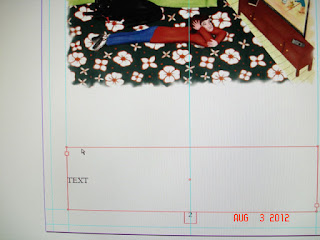

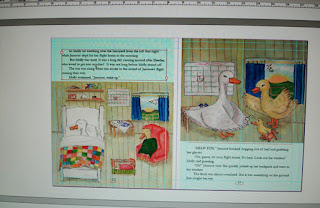







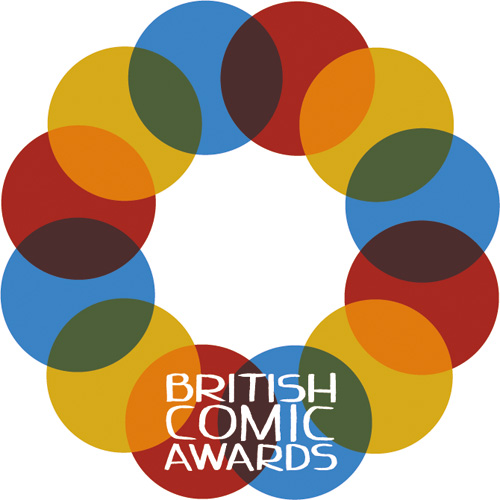








Isaac the Pirate is terrific. There are 5 volumes in French and the NBM stuff collects the first 4 (two per NBM book). Isaac is a good enough series that I check for a sixth French volume every few months hoping there will be enough material for NBM to do a third book. It’s been 8 years, so I should probably give up…
I wish more Blaine was available in English.
Hey Carter,
I’m a newly converted Blain advocate, so I’m reading all the English language stuff available. So far, that’s the Speed Abater, Isaac 1 &2, Gus and his Gang and the new cookbook with Alain Passard. I think he’s also done some of Lewis Trondheim’s Dungeon early years, but I’m a completist, so that would mean starting at the beginning of Dungeon!
I don’t have any French, so I’m just keeping my fingers crossed that someone will translate the rest of Isaac and maybe some of his other stuff too. Not holding my breath, though!